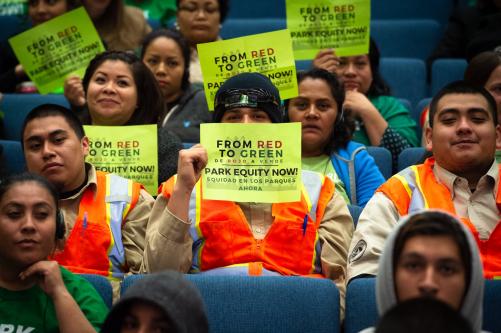
What is the People, Parks, and Power (P3) initiative?
P3 is the first national funding initiative in the U.S. to support power building by community-based organizations to reverse deep seated park and green space inequities in Black, Latino, and Indigenous communities across the country. P3 is a joint effort of the Robert Wood Johnson Foundation and the Doris Duke Charitable Foundation, led and managed by Prevention Institute. Even though there is broad consensus on the value of parks and green infrastructure, evidence shows that there are persistent inequities in access, availability, quality of facilities, and programming by race, place, and income. P3 will advance park and green space equity through a national grantmaking program, peer-to-peer learning community, national network-building, research, and communications. To learn more about park equity and the P3 approach, check out our paper, Changing the Landscape: People, Parks, and Power.
Who received P3 funding awards?
The inaugural P3 cohort includes fourteen dynamic groups, each awarded $500,000 over two years to organize diverse youth, residents, and working class and farmworker families to advocate for park and green space equity in cities throughout the continental U.S. and Puerto Rico. Together, these funded partners will advance national momentum toward an equitable future, addressing community priorities central to the environment, health, and racial justice.
Why is P3 focused on policy and systems change rather than building actual parks or green infrastructure projects in communities?
The traditional approach to addressing park inequities has focused on building new parks, recreation facilities, and green infrastructure projects in communities, or on improving existing infrastructure. While “on-the-ground” project development is crucial, it is not the focus of this initiative. Instead, P3 focuses on transforming the policies, institutional practices, power dynamics, and problematic narratives that produced large-scale inequities across populations and entire communities. The “north star” of the P3 initiative is upstream policy and system change, not planning, building, or operating individual, on-the-ground projects. Ultimately, equitable policy and systems change work will incentivize more project development in the communities hardest hit by park inequities. For additional background, please see our Theory of Change and Changing the Landscape: People, Parks, and Power.
What are some examples of policy and systems change strategies to advance park equity?
Prevention Institute’s paper Changing the Landscape: People, Parks, and Power includes examples of equitable park and green space policies that jurisdictions across the U.S. have adopted. These include but are not limited to:
- Public finance measures for parks or green infrastructure that include equity-focused criteria and funding programs
- Public agency policies that prioritize equity in internal processes and practices (e.g., budget allocations, staff diversity, etc.)
- Policy directives for a comprehensive assessment that quantifies park/green space needs and inequities
- Joint use policies for school yards to serve as park space
- Land use policies that facilitate equitable access to parks and green space
- Establishment of community engagement units within agencies
- Anti-displacement provisions in park equity policies
The “right” policy and systems change goal depends on the local context—historical, cultural, ecological, financial, and political—as well as the specific inequities and salient solutions a community has identified.
Is this a one-time funding opportunity or will there be future rounds of P3 funding available?
The P3 Call for Proposals is now closed. It is undetermined at this time whether there will be future rounds of P3 funding. We are not planning any additional rounds for the next two years. We encourage you to sign up for our P3 mailing list to stay updated on other ways to get involved with the P3 initiative, including webinars, networking opportunities, and future funding announcements. You can also sign up for RWJF funding opportunity alert emails here.
*Photo credit: Office of Los Angeles County Supervisor Hilda Solis






